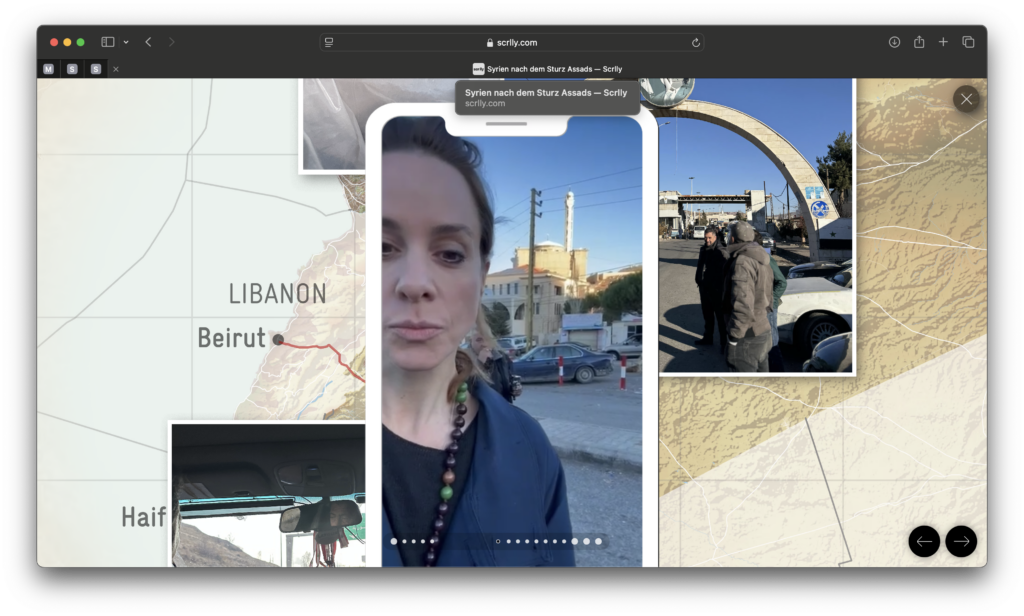Scrollytelling is a unique form of multimedia storytelling that guides users interactively through a narrative as they scroll. In contrast to static articles, the content unfolds dynamically: texts, images, videos and animations appear piece by piece and create an immersive reading experience. Current studies and statistics as well as successful practical examples from media and marketing show that this format can captivate readers. But what are the experts’ opinions on this, what technological developments are driving scrollytelling forward – and what do SEO & performance mean for these complex pages? We explore these aspects and highlight key data and sources.
Studies & statistics: User behavior with scrollytelling
Users are known to have a short attention span online: according to a Nielsen-Norman study, many leave websites after just 10-20 seconds unless they find captivating content. Typical web reading behavior is often characterized by quick scanning (e.g. in the F-pattern) – longer texts are often only skimmed. However, good scrollytelling can significantly change this behavior: Interactive presentation demonstrably increases dwell time. An early example is the award-winning New York Times feature “Snow Fall” (2012) about an avalanche accident, which kept readers on the page for an average of around 12 minutes – many times longer than the usual attention span. In total, the article achieved over 3.5 million views in its first week, with a third of readers visiting the NYT website for the first time.
This success coined the phrase “Let’s snowfall this!”, as many saw such multimedia stories as the future of digital journalism. Current figures underpin the trend: interactive data visualizations increase user engagement and the depth of reading. A study by Infogram and DC Thomson (2015) found that the average dwell time increased by 62% when an article contained data visuals. Even more remarkable: the scroll through rate to the end of the page (scroll depth) increased by 317 %. Users were far more likely to fully engage with such content. Internal company analyses also show positive effects: Imperial College London, for example, reported that multimedia feature stories achieved on average 50 % longer reading times than conventional content.
Overall, the statistics indicate that scrollytelling content has higher engagement rates – readers stay tuned longer and interact more intensively with the content. Emotionally gripping stories engage users particularly strongly: according to Nielsen Norman, users spend twice as much time on pages that appeal to them emotionally. Thanks to the successful combination of a captivating storyline and interactive presentation, scrollytelling significantly boosts both the length of stay and reader engagement.
Practical examples: Successful scrollytelling in action
Some pioneering projects in journalism and marketing have shown what is possible with scrollytelling. Here are three well-known practical examples and their successes:
New York Times – “Snow Fall” (2012): This multimedia feature about an avalanche is considered the initial spark of the scrollytelling boom. The long article combined text, videos, graphics and animations to create a gripping user journey. Snow Fallwas awarded the Pulitzer Prize in 2013 and caused a sensation across the industry. The reader response was enormous: in the first week, the NYT recorded over 3.5 million page views on the article – an extraordinary figure for a single online article. To this day, Snow Fall is considered a milestone in interactive storytelling.
The Guardian – “Firestorm” (2013): Just one year later, The Guardian published Firestorm, a lavishly produced scrollytelling report on a devastating bushfire in Tasmania. The mix of long-form text, immersive videos, audio clips and photos was published to coincide with the launch of the Guardian Australia digital edition and set new standards. Firestorm was conceived as a half-hour online experience and received a lot of critical praise: it was nominated for the Innovation Award at the prestigious Sheffield Doc/Fest, and media experts were enthusiastic. Peter Bale, Head of Digital at CNN, tweeted with foresight: “One day all journalism will look like this.” – a vision that underlines the importance of Firestorm as a role model. Other journalists also described the project as “impressive” or a “wonderful multimedia piece”, and the link was shared thousands of times on social media. Firestorm thus impressively demonstrated that scrollytelling is not just a short-lived trend, but can be a forward-looking storytelling format.
Honda – “The Engine Room” (since 2016): Scrollytelling has long been used not only in the news sector, but also in corporate communications. One example is Honda’s digital magazine Engine Room, which was launched in the UK in 2016 and fundamentally relaunched as a scrollytelling platform in 2018. The aim was to make the brand stories about technology and innovation more tangible and to attract new leads. With the help of the Shorthand platform, Honda UK transformed its static content into immersive stories – with resounding success. In the first year after the changeover, Engine Room saw an 85% increase in average dwell time and a 47% increase in click-through rate to the main website. As a result, readers spent more time on the site and clicked through more frequently. At the same time, the number of newsletter subscribers also skyrocketed (after a data reset, it increased by over 600%). This example from the corporate sector shows that scrollytelling can achieve measurable success not only in journalism, but also in content marketing – in the form of longer user loyalty and more conversions.

Expert opinions: Praise and critical voices
The rise of scrollytelling has sparked lively debate across the industry. Experts and digital strategists have often praised the format as the future of online storytelling. “Digital storytelling enables a whole range of new forms of presentation and offers the opportunity to improve the quality of journalism,” wrote media scientist Lorenz M. Sturm in his book back in 2013. The tenor after projects like Snow Fall was euphoric: “Quite a few saw the future of digital journalism in this hybrid form of text, interactive graphics, simulations and videos,” according to one analysis. There were calls across the industry for stories to be “snowfallen” – i.e. created in a similar way.
Experts also emphasize the advantages in the marketing sector: “Storytelling and scrollytelling lead to more leads”, according to a practical report, as cinematically prepared content captivates users more. Positive expert opinions particularly emphasize the increased user loyalty and innovative power. “Scrollytelling is what long texts on the web have needed for a long time,” wrote a digital design blog – finally, complex content can be delivered in a compelling way that truly draws readers in.
However, there are also critical voices that urge realistic classification. One frequently cited argument is that the production costs for high-quality scrollytelling projects are enormous. Following the hype surrounding Snow Fall, US journalist Derek Thompson soberly remarked, “there is no feasible way to make six-month sixteen-person multimedia projects the day-to-day future of journalism, nor is there a need to.” In other words, half a year’s work by a dozen people per story can hardly be constantly repeated in everyday editorial work – and usually has to be economically justified in the first place. Even eight years after the Snow case, a study found that such elaborate forms have not yet become the regular standard in the newsroom. Media companies weigh up exactly which stories are worth the great expense. Critics stress the importance of using scrollytelling judiciously – the technology should serve the story and not become an end in itself. If every little news item were to be spasmodically blown up into a “multimedia” format, this would be a departure from the path of user-friendliness. Digital expert Thompson added that there is no need to turn every story into a multimedia project. Instead, selective use is recommended: quality over quantity so as not to overwhelm users. All in all, however, proponents and admonishers agree that scrollytelling has enormous potential for suitable topics – as long as content and form are cleverly coordinated.
SEO & performance: loading time and search optimization for scrollytelling
The downside of elaborate multimedia is that special attention must be paid to performance and SEO. Scrollytelling pages tend to have larger amounts of data (high-resolution images, videos, scripts for animations), which can result in slower loading times. However, Google has made it clear that fast loading times are not a nice-to-have, but a must: Page speed has officially been one of the ranking factors since 2018, especially on mobile. In 2021, Google introduced the Core Web Vitals – metrics for loading speed, interactivity and stability – and takes these into account in searches. In short: a slow-loading page risks poorer visibility on Google.
Users themselves are also impatient: according to Google, 53% of mobile users abandon their visit if a website takes longer than 3 seconds to load. Scrollytelling projects must therefore be as performant as possible despite all media. Best practices include techniques such as lazy loading (images/videos are only loaded when they come into view, image compression and the use of modern formats (e.g. WebP), minimization of CSS/JS and caching/CDN usage. Such optimizations can drastically reduce the page load time without sacrificing visual highlights. A responsive design is also important, as many users read on the move – scrollytelling pages must therefore run smoothly on smartphones and tablets.
In addition to speed, the search engine optimization (SEO) of the content itself plays a role. Multimedia stories offer a lot of engaging content for the user, but Google crawlers can do little with purely visual elements. Therefore, scrollable pages should always contain crawlable text that describes the topic. Important content that only appears in graphics or videos should be supplemented in text form (e.g. as descriptions or transcripts). Alt tags for images are essential: a short, precise alt attribute describes the image and makes it understandable for search engines and screen readers. Captions and surrounding text also help search algorithms to understand the context. For videos, Google recommends providing subtitles or transcripts to make the content indexable. In addition, the use of structured data (Schema.org markups) for media can increase findability, for example so that videos are recognized as such in Google searches. A tip from Google’s SEO guidelines: “Create high-quality video content and embed it on a separate page with relevant accompanying text” – this advice can be applied to scrollytelling by placing all media in a narrative text context. In addition, despite all the design, the basic SEO factors should not be neglected: meaningful heading hierarchy (H1, H2, …), speaking URLs, meta tags and well thought-out internal linking. Well-optimized scrollytelling can even boost SEO, because Google rates user engagement signals (long dwell time, low bounce rate) positively. An appealing story that captivates users also indirectly improves the ranking.
Conclusion
Scrollytelling combines gripping storytelling with interactive web technology in a unique way. Current studies clearly show that users linger longer with well-made scrollytelling reports and immerse themselves more deeply in the action. Whether in news journalism or corporate marketing (Honda Engine Room): Multimedia stories capture attention and raise the bar for quality content. Experts see this as a crucial building block for the future of content distribution – but warn that the costs and benefits need to be weighed up. In terms of technology, development is by no means standing still: AI, data visualization, 3D and VR will make scrollytelling even more immersive and personalized in the coming years. At the same time, search engine optimization is forcing us to do our technical homework, despite all the creativity, to ensure that loading times and findability are right. With the right balance, however, scrollytelling projects can offer the best of both worlds: Emotionally gripping stories and enthusiastic users who are happy to embark on the scrolling adventure – and end up learning more, lingering longer and leaving with a wow feeling.




